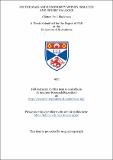Files in this item
On the mass and luminosity within isolated and binary galaxies
Item metadata
| dc.contributor.advisor | Fraser, Christopher W. | |
| dc.contributor.author | Blackman, Clinton Paul | |
| dc.coverage.spatial | 600 p. | en_US |
| dc.date.accessioned | 2018-06-20T14:01:54Z | |
| dc.date.available | 2018-06-20T14:01:54Z | |
| dc.date.issued | 1977 | |
| dc.identifier.uri | https://hdl.handle.net/10023/14350 | |
| dc.description.abstract | The aim of this project has been to study the detailed mass and luminosity distributions within spiral galaxies, with particular emphasis on the comparison of isolated and binary systems. A large programme of photographic U, B, Y and E surface photometry has been completed using the St. Andrews 1m Schmidt-Cassegrain telescope, and a series of computer programmes have been written to evaluate the detailed luminosity distribution of galaxies, using data from a computer -controlled, plate-scanning. Spectroscopic observations of a number of binary galaxy systems have also been made, using the Isaac Newton Telescope and the 195cm telescope at mute Provence, and well-defined rotation curves have been obtained for the galaxies in three systems. The photometry of these galaxies and of ten isolated galaxies with known rotation curves has revealed an extra outer component in the integrated luminosity distributions which has not been widely noted before. For these galaxies, the variation in mass to luminosity ratio (M/L) has been studied at large radii by extrapolating the observed rotation curves, using an empirical formula. This has revealed a general tendency for M/L to decrease with increasing radius. For most galaxies, a small, but well-defined outer peak is also seen, coinciding with the boundary of the outer component in the luminosity distribution. It is postulated that the outer component corresponds to those parts of the galaxies lying outside the outer Lindblad resonance, and this has been confirmed comparing the spiral pattern obtained from density wave theory with the 034ervod structure of the galaxies. This implies that the rotation curves are not at large radii, as they would be if a massive halo were present. This is by the fact that the luminosities of the outer components are too large for much a nalo, according to recent estimates of halo properties. In their gross properties, the binary galaxies do not differ from the isolated Two of the galaxies are, however, very luminous for their mass, and this is explained qualitatively by the tidal forces due to the neighbouring galaxy, with increase the strength of the shocks associated with the spiral arms, extrapolating to the density wave model, in turn giving rise to enhanced star formation. | en_US |
| dc.language.iso | en | en_US |
| dc.publisher | University of St Andrews | |
| dc.subject.lcc | QB814.B6 | |
| dc.subject.lcsh | Stars--Initial mass function--Congresses | en |
| dc.title | On the mass and luminosity within isolated and binary galaxies | en_US |
| dc.type | Thesis | en_US |
| dc.contributor.sponsor | Carnegie Trust for the Universities of Scotland | en_US |
| dc.contributor.sponsor | Science Research Council (Great Britain) | en_US |
| dc.type.qualificationlevel | Doctoral | en_US |
| dc.type.qualificationname | PhD Doctor of Philosophy | en_US |
| dc.publisher.institution | The University of St Andrews | en_US |
| dc.publisher.department | University of St Andrews Observatory; St Andrews University Computing Laboratory; Royal Greenwich Observatory; Herstmonceux; L'observatoire de Haute Provence | en_US |
This item appears in the following Collection(s)
Items in the St Andrews Research Repository are protected by copyright, with all rights reserved, unless otherwise indicated.

